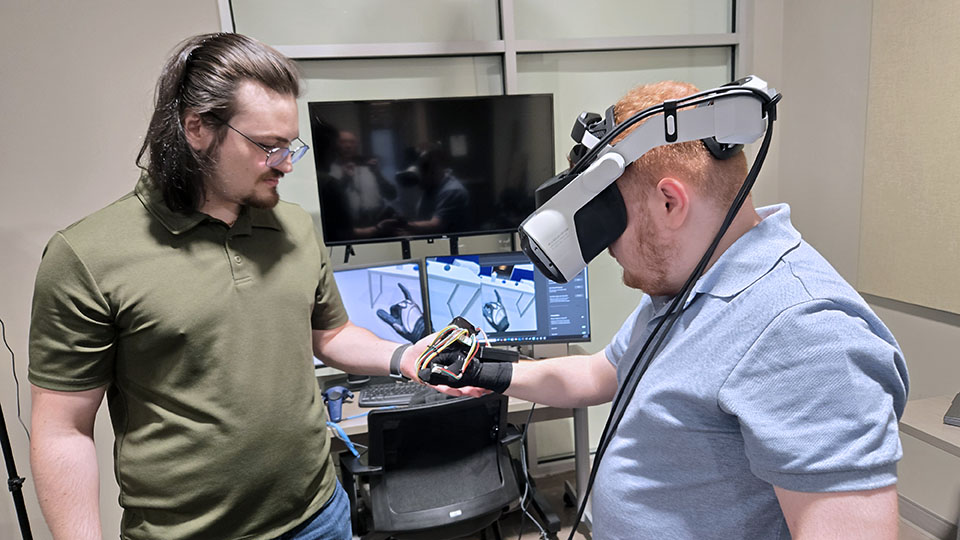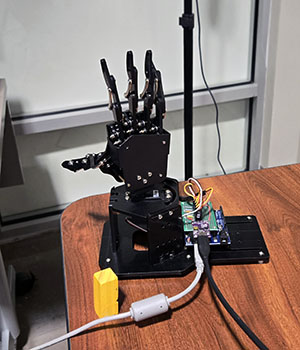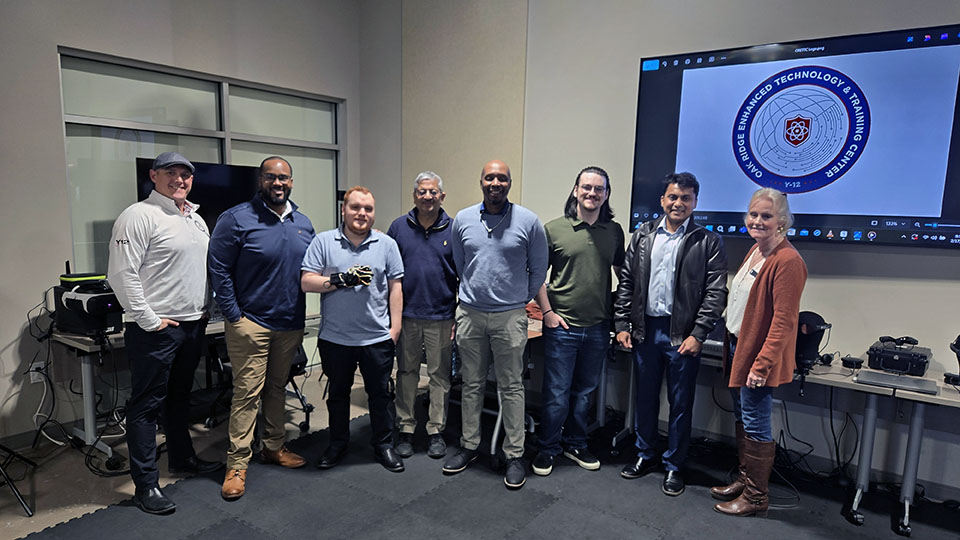Small demonstration could yield big results at Y-12

FIU graduate students Julian Guerra (L) and Brad Alvarez manipulate a haptic glove
On February 17, a Florida International University (FIU) graduate student, Brad Alvarez, placed a device called a haptic glove onto his hand and worked the glove’s fingers, remotely manipulating a robotic hand from a short distance away.
This small demonstration, conducted at the Oak Ridge Enhanced Technology and Training Center (ORETTC), drew a round of applause and big smiles from the observers surrounding Alvarez.
Among them was ORETTC Director Ashley Stowe because he saw the potential this glove could bring Y‑12.
“We use haptic gloves as a training tool in a virtual reality environment,” Stowe said. “They allow workers to do hazardous work training without actually being in a hazardous environment.”

Robotic hand connected remotely to haptic glove. (Photo by Gene Patterson.)
This advancement, Stowe explained, takes hazardous work safety a step further, allowing trained workers to be removed from the hazard while controlling robots in the hazard area to accomplish a task.
“Potentially, this could have a huge impact on how we do work at Y‑12,” Stowe said.
The technology is being developed in partnership with Florida International University. Dr. Shekhar Bhansali heads the program, assisted by Research Scientist Dr. Vivek Kamat.
“We’ve worked with Y‑12 for the past 4 ½ years, and it’s been a great benefit for our students and for Y‑12,” Bhansali said. “It allows us to advance new technologies while training our students in real‑world settings and helps us place students on a career path.”
Those career paths can take the students in many directions. Working with both software and hardware is a big reason FIU students enjoy their time in Oak Ridge.
“We want students involved in this program who are serious about the work,” Kamat added. “These students start from scratch to work a problem, develop a design, and create something new and innovative.”
One of those “serious” students is Miami Native Julian Guerra. He arrived at ORETTC in September 2024 as a co‑op student funded through the Minority Serving Institution Partnership Program (MSIPP). Cooperative education programs, similar to internships, allow students to alternate between academic studies and real‑world practical experiences.
“The partnership with FIU is a shining example of how the MSIPP program can produce top‑tier talents that are uniquely qualified to impact the Y‑12 mission,” Y‑12 Workforce Program Advisor Sanchez Harley said.

ORETTC and FIU partners: (from left) ORETTC Director Ashley Stowe, ORETTC’s Austin Arnwine, FIU Student Brad Alvarez, FIU Instructor Dr. Shekhar Bhansali, CNS Workforce Program Advisor Sanchez Harley, FIU Student Julian Guerra, FIU Researcher Dr. Vivek Kamat, and ORETTC’s Mary Lin. (Photo by Gene Patterson.)
Stowe agrees. “Universities, like FIU, are a vital part of our forward‑looking instructional technology research,” he said. “We, government labs, have a tendency to fall into a standard way of thinking based on our strict regulatory environment. Professors and students bring creativity to our landscape and a different way of thinking.”
Stowe said Guerra has integrated quickly and easily with the ORETTC team and described his work ethic and attitude as “fantastic.”
Guerra says his experience in Oak Ridge has been “more than expected.”
“When I arrived at ORETTC, I would say my knowledge was mostly theoretical, based on coursework and research. My hands‑on experience was limited,” Guerra said.
In just a few short months, that has changed.
“ORETTC has given me a better understanding of what it’s like to work in a rapidly developing industry,” Guerra said. He added the experience was beneficial for him in several ways, including growing skills through hands‑on experiences, collaborating with skilled professionals and subject matter experts, and, most importantly, contributing meaningfully to projects.
“I get to work in a lot of different areas. There’s so much to do. It’s like playing with toys, except in this case, we’re creating really cool stuff,” Guerra added.
Stowe said a benefit from students like Guerra coming and working at Y‑12 is their ability to see problems from a different perspective, allowing industry professionals to be led to new areas — like the haptic glove interface with a robot, which Stowe believes is just the beginning of technology that’s to come.
“These are very bright students who are up on the latest technologies,” Stowe said. “We want to tap into that knowledge base and help them help us. It’s a win‑win.”
